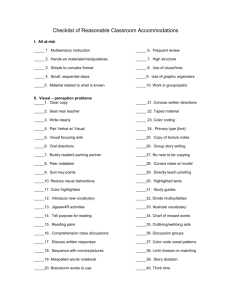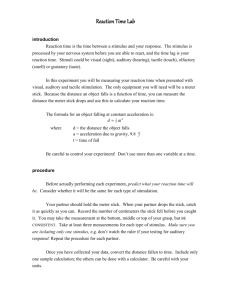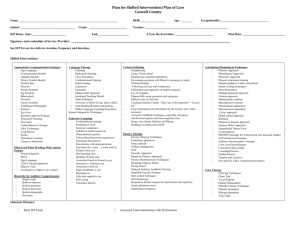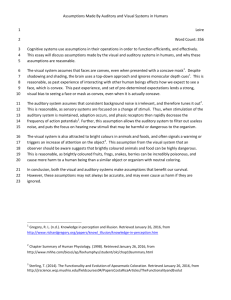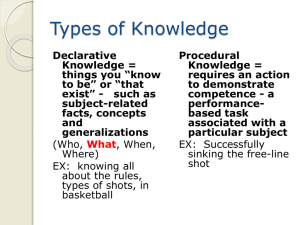Poster presentation example
advertisement
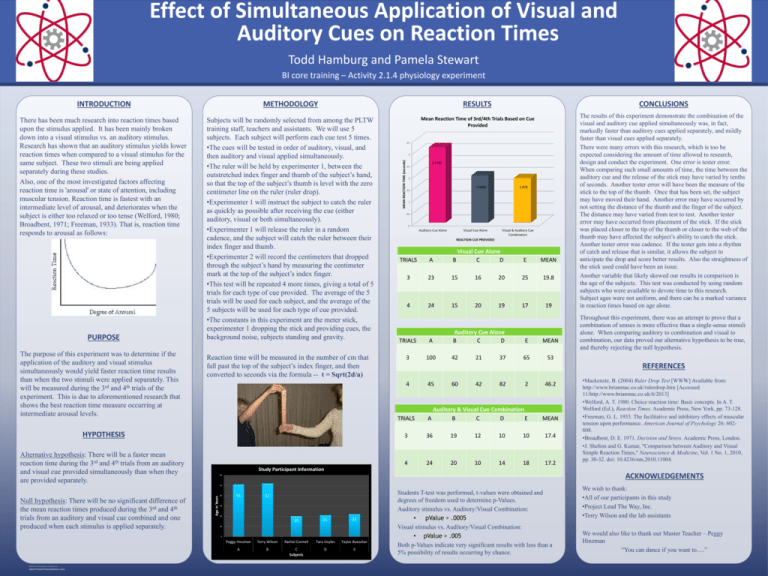
Effect of Simultaneous Application of Visual and Auditory Cues on Reaction Times Todd Hamburg and Pamela Stewart BI core training – Activity 2.1.4 physiology experiment There has been much research into reaction times based upon the stimulus applied. It has been mainly broken down into a visual stimulus vs. an auditory stimulus. Research has shown that an auditory stimulus yields lower reaction times when compared to a visual stimulus for the same subject. These two stimuli are being applied separately during these studies. Also, one of the most investigated factors affecting reaction time is 'arousal' or state of attention, including muscular tension. Reaction time is fastest with an intermediate level of arousal, and deteriorates when the subject is either too relaxed or too tense (Welford, 1980; Broadbent, 1971; Freeman, 1933). That is, reaction time responds to arousal as follows: PURPOSE The purpose of this experiment was to determine if the application of the auditory and visual stimulus simultaneously would yield faster reaction time results than when the two stimuli were applied separately. This will be measured during the 3rd and 4th trials of the experiment. This is due to aforementioned research that shows the best reaction time measure occurring at intermediate arousal levels. METHODOLOGY RESULTS Subjects will be randomly selected from among the PLTW training staff, teachers and assistants. We will use 5 subjects. Each subject will perform each cue test 5 times. •The cues will be tested in order of auditory, visual, and then auditory and visual applied simultaneously. •The ruler will be held by experimenter 1, between the outstretched index finger and thumb of the subject’s hand, so that the top of the subject’s thumb is level with the zero centimeter line on the ruler (ruler drop). •Experimenter 1 will instruct the subject to catch the ruler as quickly as possible after receiving the cue (either auditory, visual or both simultaneously). •Experimenter 1 will release the ruler in a random cadence, and the subject will catch the ruler between their index finger and thumb. •Experimenter 2 will record the centimeters that dropped through the subject’s hand by measuring the centimeter mark at the top of the subject’s index finger. •This test will be repeated 4 more times, giving a total of 5 trials for each type of cue provided. The average of the 5 trials will be used for each subject, and the average of the 5 subjects will be used for each type of cue provided. •The constants in this experiment are the meter stick, experimenter 1 dropping the stick and providing cues, the background noise, subjects standing and gravity. Mean Reaction Time of 3rd/4th Trials Based on Cue Provided Reaction time will be measured in the number of cm that fall past the top of the subject’s index finger, and then converted to seconds via the formula -- t = Sqrt(2d/a) 3 3.1799 2.5 2 1 0.5 0 Auditory Cue Alone Visual Cue Alone Visual & Auditory Cue Combination REACTION CUE PROVIDED TRIALS A Visual Cue Alone B C D 3 23 15 16 20 25 19.8 4 24 15 20 19 17 19 TRIALS A 3 100 E MEAN Auditory Cue Alone B C D E MEAN 42 65 53 21 37 45 60 42 82 2 Auditory & Visual Cue Combination A B C D E 46.2 MEAN 3 36 19 12 10 10 17.4 4 24 20 10 14 18 17.2 www.PosterPresentations.com •Mackenzie, B. (2004) Ruler Drop Test [WWW] Available from: http://www.brianmac.co.uk/rulerdrop.htm [Accessed 11/http://www.brianmac.co.uk/6/2013] •Welford, A. T. 1980. Choice reaction time: Basic concepts. In A. T. Welford (Ed.), Reaction Times. Academic Press, New York, pp. 73-128. •Freeman, G. L. 1933. The facilitative and inhibitory effects of muscular tension upon performance. American Journal of Psychology 26: 602608. •Broadbent, D. E. 1971. Decision and Stress. Academic Press, London. •J. Shelton and G. Kumar, "Comparison between Auditory and Visual Simple Reaction Times," Neuroscience & Medicine, Vol. 1 No. 1, 2010, pp. 30-32. doi: 10.4236/nm.2010.11004. ACKNOWLEDGEMENTS 60 Age in Years 40 51 52 30 20 20 21 22 10 0 RESEARCH POSTER PRESENTATION DESIGN © 2012 Throughout this experiment, there was an attempt to prove that a combination of senses is more effective than a single-sense stimuli alone. When comparing auditory to combination and visual to combination, our data proved our alternative hypothesis to be true, and thereby rejecting the null hypothesis. Study Participant Information 50 Null hypothesis: There will be no significant difference of the mean reaction times produced during the 3rd and 4th trials from an auditory and visual cue combined and one produced when each stimulus is applied separately. The results of this experiment demonstrate the combination of the visual and auditory cue applied simultaneously was, in fact, markedly faster than auditory cues applied separately, and mildly faster than visual cues applied separately. There were many errors with this research, which is too be expected considering the amount of time allowed to research, design and conduct the experiment. One error is tester error. When comparing such small amounts of time, the time between the auditory cue and the release of the stick may have varied by tenths of seconds. Another tester error will have been the measure of the stick to the top of the thumb. Once that has been set, the subject may have moved their hand. Another error may have occurred by not setting the distance of the thumb and the finger of the subject. The distance may have varied from test to test. Another tester error may have occurred from placement of the stick. If the stick was placed closer to the tip of the thumb or closer to the web of the thumb may have affected the subject’s ability to catch the stick. Another tester error was cadence. If the tester gets into a rhythm of catch and release that is similar, it allows the subject to anticipate the drop and score better results. Also the straightness of the stick used could have been an issue. Another variable that likely skewed our results in comparison is the age of the subjects. This test was conducted by using random subjects who were available to devote time to this research. Subject ages were not uniform, and there can be a marked variance in reaction times based on age alone. REFERENCES TRIALS Alternative hypothesis: There will be a faster mean reaction time during the 3rd and 4th trials from an auditory and visual cue provided simultaneously than when they are provided separately. 1.878 1.9888 1.5 4 HYPOTHESIS CONCLUSIONS 3.5 MEAN REACTION TIME (seconds) INTRODUCTION Peggy Hinzman Terry Wilson Rachel Connell Tara Voyles Taylor Buescher A B C Subjects D E Students T-test was performed, t-values were obtained and degrees of freedom used to determine p-Values. Auditory stimulus vs. Auditory/Visual Combination: • pValue > .0005 Visual stimulus vs. Auditory/Visual Combination: • pValue > .005 Both p-Values indicate very significant results with less than a 5% possibility of results occurring by chance. We wish to thank: •All of our participants in this study •Project Lead The Way, Inc. •Terry Wilson and the lab assistants We would also like to thank our Master Teacher – Peggy Hinzman “You can dance if you want to….”
